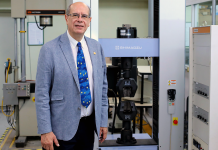
Who is Dante Solutions, and what do you do with the company?
Dante Solutions is an engineering company with a main focus on improving heat treatment processes by application of sophisticated modeling tools. We do this so we can better understand the metal’s response to heat treatment. This provides part-performance improvement through control of dimensions, control of microstructure, and control of final part stress state.
Our Dante software is a big part of this company, though it’s far from who we are as a whole. As a whole, we’re a group of mechanical engineers, process engineers, and software engineers, and we all have backgrounds in manufacturing processes, metallurgy, and failure analysis.
I’m a mechanical engineer here, and my job duties are generally principal engineer on consulting projects and training new Dante users. But I also do marketing, sales, IT, a little bit of everything.
What does Dante do for the heat treat industry?
We really have two main avenues to help the industry: Our first is our flagship software Dante. The second is our consulting services for troubleshooting existing processing problems or by taking more of a proactive approach and actually helping in process design. The tools and services we offer allow for faster implementation of new alloys and processes. They also help make part performance more reliable by having more dimensionally consistent parts from the processes, as well as consistent microstructure and hardness, while avoiding detrimental heat-treat related issues such as quench cracking, carbide formation, poor case depths, and bad residual stress profiles.
What is the Dante Flagship software, and how is it beneficial to the heat-treat industry?
Our flagship software is called Dante, which is an acronym for Distortion Analysis for Thermal Engineering. It’s used to predict the metallurgical phase fractions, hardness, distortion, and residual stress from a thermal process. Our software also has a large database of materials that gives us a leg up over the competition. Chances are users won’t even have to supply their own data, which is really significant because this isn’t like a normal stress simulation where you just need room temperature values. We have to collect data over an entire range of temperatures all the way from room temperature to 2,000 F. Having that data on hand for our customers is really big.
The Dante software can be a tremendous help to the industry where it can be used for troubleshooting and root cause failure analysis from quench cracking. But while that’s a great use, we also like to see it used as a design tool. By using the software, green shapes can be fine-tuned for current processes or processes can be fine-tuned for a specific geometry. Grind stock can be determined accurately because you’ll know the final dimensions after heat treat. Materials can be determined based on processing options and cross-sectional thickness. If you’re stuck with one process, then what materials can I use? We even consider the carbide growth and dissolution for materials with strong carbide forming elements, so we’re beyond Fick’s second law of mass diffusion. But as far as troubleshooting of the heat-treat process goes, the biggest benefit is that it removes that black box.
What is the black box?
In the past in heat treating, you know what goes in as far as microstructure and dimensions, and you know what comes out, but you really have no idea what happens in between. It’s basically a mystery. That’s the “black box.” By using the Dante software, one is able to see what happens during heat treatment in terms of thermal and microstructural stresses and strains. And then one’s able to determine where the stresses and strains come from, which are usually related to phase transformation timings. Then you’re able to use the software to conduct virtual trials to eliminate or reduce these unwanted stresses and strains. The software really does allow for a fundamental understanding of the heat treat process.
Where do you see heat treat in 10-20 years, and Dante’s place in that future?
With respect to the heat-treatment simulation software, which is really where we want to be, we still want to offer consulting services just to stay current and to help those customers who don’t have the capabilities to run the software. But we really want our focus to be on the software side. In the next decade or two, we see a big movement toward making modeling part of the heat-treat process path definition. And what I mean by that is we see part designers beginning to use the software to actually define the heat treatment of their parts as opposed to providing specifications. The downside then becomes: Where does the heat treater stand in all this? And the heat treater can turn around and use simulation to essentially advance the technology.
By using the software, they can run virtual trials instead of actual physical experiments to optimize processes, which reduces cost and time tremendously. But heat treaters can also use the software as a training tool for new hires as a way to offset “brain drain” from those experienced personnel who are retiring. We really feel that that’s one of the big benefits of simulation.
MORE INFO dante-solutions.com

























